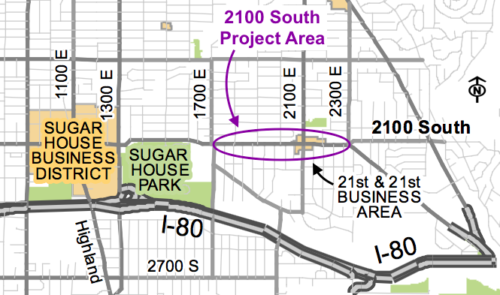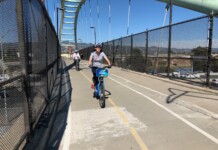
June 7, 2017 – Salt Lake City today announced a proposed redesign of 2100 S from 1700 E to 2300 E. The roadway will be resurfaced with a slurry seal later this summer. Three proposals are being considered.
- Restripe and go from 4 travel lanes to 2 and a center turn lane, with bike lanes. (This is Salt Lake City’s recommended option)
- Restripe and go from 4 travel lanes to 2 and a center turn lane, with no bike lanes.
- Restripe and keep the same pattern of 2 traffic lanes in each direction with no bike lanes.
The preferred proposal seems to be number 1. This should result in a 30% reduction in motor vehicle crashes if the redesign results are like those of 1300 S and California Avenue are any indication. If bike lanes are added, there would likely be a further reduction in bike/vehicle crashes.
Article continues below
To comment on this:
-
Preferred Option: Participate in Open City Hall through July 4, 2017: http://www.slcgov.com/opencityhall
-
Email: [email protected] or call 801-535-7130 or email [email protected]
- Come to the open house:
Project Open House – Thursday, June 22, 2017, 6-7:30 pmArch Nexus, 2505 Parleys Way.
- Or, use our email form: [emailpetition id=”2″]
Bike lanes on this stretch of 2100 S are part of the 2015 Pedestrian and Bicycle Master Plan. Additionally, they are indicated in the 21st and 21st area master plan.
The lane reduction from 4 to 3 is called a Road Diet. Road Diets have many benefits. According to the Federal Highway Administration, they enhances safety, mobility, and access (safety.fhwa.dot.gov/road_diets/):
“A roadway reconfiguration known as a Road Diet offers several high-value improvements at a low cost when applied to traditional four-lane undivided highways. In addition to low cost, the primary benefits of a Road Diet include enhanced safety, mobility and access for all road users and a “complete streets” environment to accommodate a variety of transportation modes.
A classic Road Diet typically involves converting an existing four-lane, undivided roadway segment to a three-lane segment consisting of two through lanes and a center, two-way left-turn lane.
The resulting benefits include a crash reduction of 19 to 47 percent, reduced vehicle speed differential, improved mobility and access by all road users, and integration of the roadway into surrounding uses that results in an enhanced quality of life. A key feature of a Road Diet is that it allows reclaimed space to be allocated for other uses, such as turn lanes, bus lanes, pedestrian refuge islands, bike lanes, sidewalks, bus shelters, parking or landscaping.
Why consider a Road Diet? Four-lane undivided highways experience relatively high crash frequencies — especially as traffic volumes and turning movements increase over time — resulting in conflicts between high-speed through traffic, left-turning vehicles and other road users. FHWA has deemed Road Diets a proven safety countermeasure and promotes them as a safety-focused design alternative to a traditional four-lane, undivided roadway. Road Diet-related crash modification factors are also available for use in safety countermeasure benefit-cost analysis.
As more communities desire “complete streets” and more livable spaces, they look to agencies to find opportunities to better integrate pedestrian and bicycle facilities and transit options along their corridors. When a Road Diet is planned in conjunction with reconstruction or simple overlay projects, the safety and operational benefits are achieved essentially for the cost of restriping. A Road Diet is a low-cost solution that addresses safety concerns and benefits all road users — a win-win for quality of life.
Road Diets stand the test of time, having been implemented by transportation agencies for more than three decades. One of the first installations of a Road Diet was in 1979 in Billings, Montana. Road Diets increased in popularity in the 1990s. Cities, including Charlotte, Chicago, New York, Palo Alto, San Francisco and Seattle, have also opted for the positive impact Road Diets bring to their communities.”
Already, there is some opposition to the plan from Councilman Charlie Luke. Luke posted on Facebook yesterday, “I can tell you on this page that I am very opposed to any administrative plan that includes reducing traffic lanes on 2100 South.” Luke goes on to say that cyclists can ride elsewhere, “Bike lanes are good, but the six block section on 2100 S is already narrow. The city has identified 1700 S as a bike-friendly street. Parleys Canyon Blvd is another safer option. There is also the issue of commuter traffic spreading onto neighborhood streets. Residents near 1300 E complain regularly about increases traffic on streets not designed for heavy travel.”
Former Councilman Soren Simonsen is in favor of the redesign. He posted the following:
“Sugarhouse friends and neighbors, and bicycle and pedestrian advocates — good news! 2100 South may be finally getting its long awaited bike lanes.
These improvements have been planned for decades, and reiterated as official city policy in the 2005 Sugar House Master Plan, the more recently in the 2015 City Wide Bike & Pedestrian Plan. Bike lanes are also a recommendation in the 21st & 21st Small Area Plan, now in front of the City Council for adoption.
“Complete streets” are good for mobility, improve air quality, create safer neighborhoods, and increase business.
Please join the Sugar House Community Council meeting Wednesday evening to encourage this much needed “complete street” makeover, or submit comments online by email using the link provided.
If you have questions about “complete streets” please read this article that gives a good overview, and specifically addresses the configuration proposed for 2100 South — changing four car lanes to two lanes, center turn lane, and bike lanes — that will actually improve traffic flow while also making the street safer for bikes, pedestrians and cars as well:
http://www.govtech.com/fs/Redesigning-Roads-Taking-a-Look-at-the-Complete-Streets-Movement.html.”
Analysis and Commentary:
Cycling Utah is fully in favor of the redesign of 2100 S from 1700 E to 2300 E to include bike lanes and a road diet.
Road Diets are safer and keep traffic moving better than streets without a center turn lane. Automobile crashes will likely decrease because speed differentials are decreased. It will be safer for people on bikes and foot too. And, bike use should increase. According to Salt Lake City (sugarhousecouncil.org/2017/06/07/2100-s-redesign-proposal-1700-e-2300-e/) traffic throughput is not likely to change either.
Sugarhouse has too much traffic as it is. Keeping an outdated road design is not going to solve this issue. In fact, the old design will result in more traffic in the future. What will help solve this is a shift from auto to human powered transportation, and increased transit options.
The quality of life in Sugarhouse depends on a calmer neighborhood. Keeping 4 lanes will just result in induced demand of more traffic rather than less.
Salt Lake City needs to continue moving forward, not backward, and should consider buffered bike lanes on this stretch as part of the redesign if there is space.
2100 S should eventually be redesigned from Foothill to 300 West (and beyond) and this should include bike lanes. Bike lanes in this region between 1700 E and 2300 E are a key beginning of a more friendly Sugarhouse.
Lastly, all streets should be safe for all modes of transportation. Why would we ask people on bikes or people walking to go several blocks out of their way when we don’t ask the same of drivers on those same streets?
Arterials are key corridors for people in bikes, people in cars, people in transit, and people on foot because they go to the destinations where all people want to go and, they tend to be the most direct route from A to B.
More background information is here: https://sugarhousecouncil.org/2017/06/07/2100-s-redesign-proposal-1700-e-2300-e/
Note that the proposal was discussed at the June 7, 2017 Sugarhouse Community Council Meeting:
https://sugarhousecouncil.org/2017/05/31/meeting-agenda-june-7-2017/








